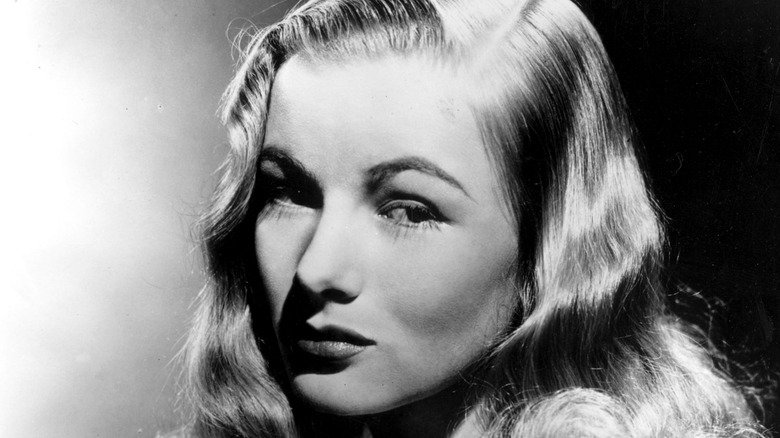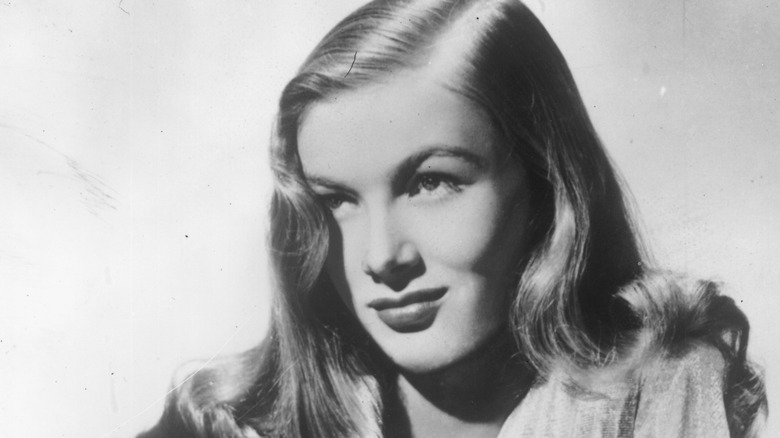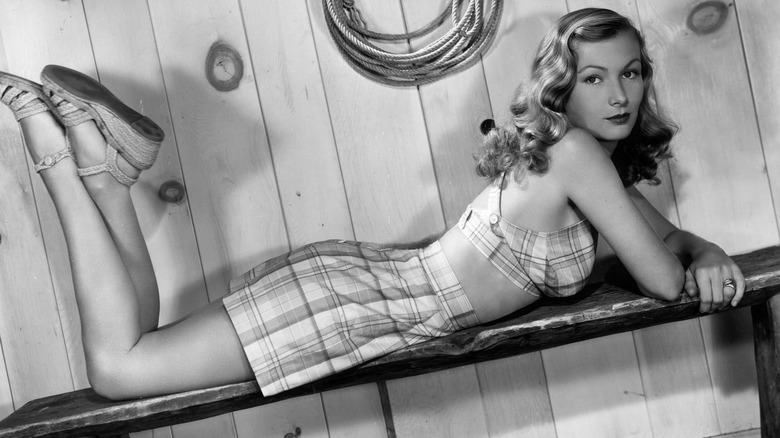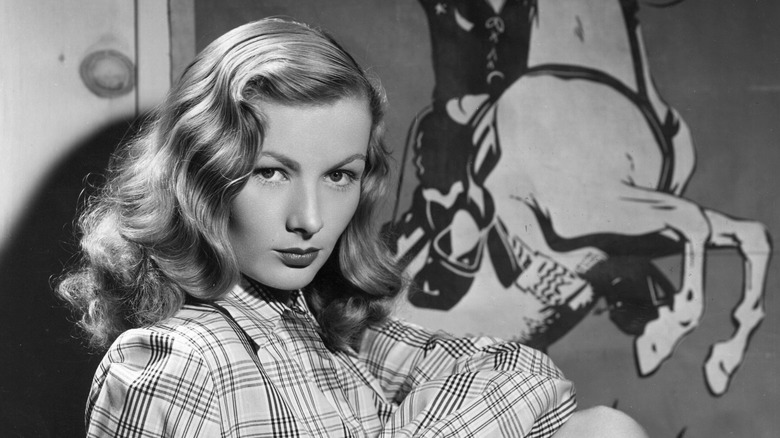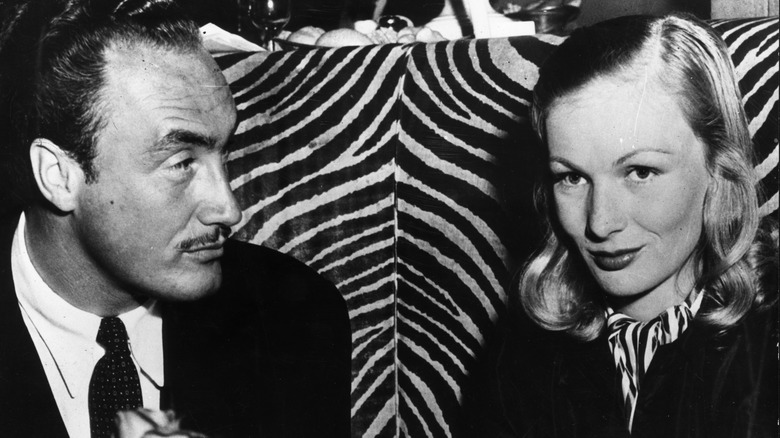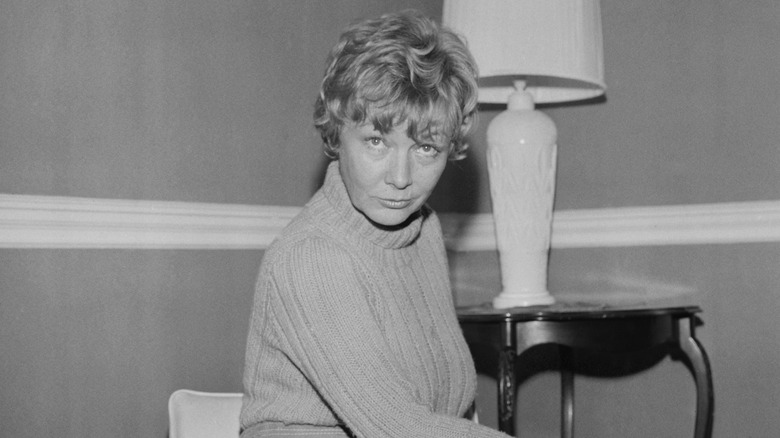The Tragic Story Of Veronica Lake's Role In The Hour Before The Dawn Explained
In the 1940s, Veronica Lake was Hollywood's golden girl (via the Sarasota Herald-Tribune). Known for her signature blonde hair in a peekaboo style, she sadly faded into obscurity. According to TCM, Lake starred in iconic films such as "The Blue Dahlia," "I Married a Witch," and more. LiveAbout writes that she often made noirs alongside fellow actor Alan Ladd. However, she wasn't always called Veronica Lake. Born Constance Frances Marie Ockelman (adding Keane later on once her mother remarried), Hollywood's Golden Age reports that her name was eventually changed by a Paramount producer.
Despite only standing 4'11," Lake made an impression when she starred in 1941s "I Wanted Wings." The young starlet had sex appeal and was alluring, (she would later inspire Kim Basinger's character in the 1997 film "LA Confidential.") Lake subsequently made "Sullivan's Travels," a film that made her a full-fledged star. She proceeded to star in a string of successful films. Then in 1944, she made "The Hour Before the Dawn," a film that marked the beginning of the end for Lake (per Diabolique Magazine).
Veronica Lake's beginnings
According to the Sarasota Herald-Tribune, Lake was born in Brooklyn but moved to Florida in the 1930s at the age of 15. In many ways, this was the start of her career. Hollywood's Golden Age writes that she entered and won various beauty pageants in Miami. It's also reported that sometime in her teenage years, Lake was diagnosed with a mental illness. This, however, did not deter her from following her dreams of stardom and in 1938, she and her family moved to Los Angeles (via Diabolique Magazine). There, Lake enrolled in acting classes and took on small film roles.
TCM reports that her rise to the top was swift and she was signed to Paramount films in 1941. Despite her early forgettable bit parts, Lake's striking looks proved noteworthy. After she starred in "I Wanted Wings," she proved she was more than just a pretty face. At one point during filming, her hair fell over her right eye, creating her now-iconic look that has been emulated by women since. Lake subsequently starred in five hit films back to back, making her one of Paramount's biggest stars. As America had recently entered World War II, she did her part to support the troops.
Veronica Lake's war efforts
In 1942, Lake went on tour throughout the U.S. to sell war bonds (per Sarasota Herald-Tribune). At this point in time, she and her hair were incredibly popular. When Lake's tour stopped in Florida, she was mobbed by devotees. One reporter noted that "No one can talk to Miss Lake for more than five minutes without sensing that she is very definitely all out for service to her country at this time." To boost the morale of troops, TCM writes that she also starred in "Star-Spangled Rhythm." The National WWII Museum describes it as a musical intended to entertain soldiers that were overseas.
Lake was then asked to change her hair by the government. According to The Vintage News, women were forced into the workforce when the U.S. entered World War II. As many of them had imitated Lake's famous peekaboo hairstyle, this led to various factory injuries when their long hair got tangled up in machinery. Thus, she began to put her hair up in victory rolls and even filmed a tutorial for fans. Although some attribute her new hair to her career's decline, Lake had already gained a reputation for being difficult to work with.
'The Hour Before the Dawn' Flopped
In 1943, Lake began filming "The Hour Before The Dawn" (via TCM). Directed by Frank Tuttle, IMDb writes that she plays Dora Bruckmann, a secret Nazi agent that's married to an Englishman. Needless to say, fans and critics condemned the subject matter, especially after all of Lake's war efforts. When the film was released in 1944, it bombed at the box office (per Diabolique Magazine). Lake was blamed for the film's failure and critics panned her poorly done German accent. To make matters worse, "The Hour Before The Dawn" had resulted in a personal tragedy for the star.
According to the Independent, Lake, who was pregnant at the time, tripped over a cable while filming. Hollywood's Golden Age reports that her son (her second child with husband John S. Detlie) was born prematurely and died shortly after. By the time "The Hour Before the Dawn" had been released, Lake and Detlie had divorced. She began to drink heavily and slowly descended into mental illness. Although she was given a role in the 1945 film "Bring on the Girls" and in 1946's "The Blue Dahlia," Lake's career continued to falter.
Veronica Lake's career never recovered
The Independent writes that in 1948, Lake's contract with Paramount came to an end. Her films made after "The Hour Before the Dawn" flopped and her demeanor became more and more unprofessional (via Hollywood's Golden Age). According to the Sarasota Herald-Tribune, her costars spoke badly of her and noted that she was always hungover or late to set. Lake had married director Andre de Toth (seen above) in 1944 and TCM reports that the marriage had only worsened her drinking and mental state. By 1951, Lake's career was effectively over. That same year, she divorced de Toth, with whom she had two children, and filed for bankruptcy.
Diabolique Magazine reports that Lake's life continued on a downward spiral. Her mother sued her for financial support and she eventually became estranged from her four children. Although she had left Hollywood, Lake continued to act and began doing theater work around Palm Beach. In the late 1950s, she disappeared from the public eye for a number of years until she made a small return to show business.
Veronica Lake's final years
TCM writes that in the early 1960s, Lake was discovered working at a bar in New York City by a reporter. A story was published about this encounter and Lake was back in the headlines. The Sarasota Herald-Tribune writes that she once again began doing theater work. Eventually, she returned to the silver screen and starred in two low-budget films, "Footsteps in the Snow" and "Flesh Fiend" (per Diabolique Magazine). Lake also penned an autobiography in 1970 titled "Veronica" in which she wrote that she had no regrets over her Hollywood career but did have remorse over abandoning her children.
The book also delved into struggles with mental illness and alcoholism. According to the Los Angeles Times, Veronica Lake died penniless and alone in Vermont on July 7, 1953. She was 51 years old. Per Hollywood's Golden Age, her death was caused by hepatitis and renal failure. Although it was believed that her ashes were scattered off the coast of Miami by friends, some were later found in an antique store in the Catskills (via Today).
